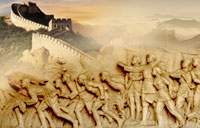Experts gathered a week ago to ready for earthquake
By Associated Press in Katmandu (China Daily) Updated: 2015-04-27 07:48
Nepal's devastating earthquake was the disaster experts knew was coming.
Just a week ago, about 50 earthquake and social scientists from around the world came to Kathmandu to figure out how to get this poor, congested, shoddily built area to prepare better for the big one, a repeat of the 1934 temblor that leveled the city. They knew they were racing the clock, but they didn't know when what they feared would strike.
"It was sort of a nightmare waiting to happen," said seismologist James Jackson, head of the earth sciences department at the University of Cambridge in England. "Physically and geologically, what happened is exactly what we thought would happen."
But he didn't expect the massive quake that struck Saturday to happen so soon. The magnitude-8.1 earthquake killed more than 2,200 and counting and caused widespread destruction.
"I was walking through that very area where that earthquake was and I thought at the very time that the area was heading for trouble," said Jackson, lead scientist for meeting organizer Earthquakes Without Frontiers, a group that tries to make Asia more able to bounce back from these disasters.
A Kathmandu earthquake has long been feared, not just because of the natural seismic fault but because of the local, more human conditions that make it worse.
The same size shaking can have bigger effects in different parts of the globe because of building construction and population, and that's something the US Geological Survey calculates ahead of time. So the same level of severe shaking would cause 10 to 30 people to die per million residents in California, but 1,000 or maybe more in Nepal, and up to 10,000 in parts of Pakistan, India, Iran and China, said USGS seismologist David Wald.
While the trigger of the disaster is natural - an earthquake - "the consequences are very much man-made," Jackson said. Except for landslides, which in this case are a serious problem, "it's buildings that kill people not earthquakes," Jackson said. If you lived in a flat desert with no water, an earthquake wouldn't harm you, but then few people want to live there.
"The real problem in Asia is how people have concentrated in dangerous places," Jackson said.
Kathmandu was warned, first by Earth itself: this is the fifth significant quake there in the last 205 years, including the massive one in 1934.
"They knew they had a problem, but it was so large they didn't know where to start, how to start," said Hari Ghi, Southeast Asia regional coordinator for Geohazards International, a group that works on worldwide quake risks. Ghi, Jackson and Wald said Nepal was making progress on reducing its vulnerability to earthquakes, but not quickly or enough.






